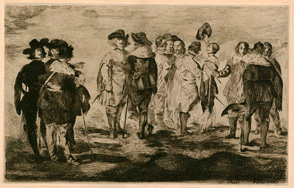|

|
P. 248x390mm.,
S. 410x580mm.
|
Les Petits
Cavaliers
Moreau-Nélaton
5, Guérin 8, Harris 5, Fisher 6, Wilson-Bareau 23
etching, drypoint, roulette,
and aquatint, 1861-62, on fine greyish Chine appliqué
over a heavy cream vellum paper, the 3rd state* (of 5), a very
fine impression, rich yet cleanly wiped, with burr on the drypoint
work (notably the shoulder of the central cavalier), with wide
margins, slight lightstaining above, and a faint crease in the
upper margin, away from the image, slight soiling and traces
of an old hinge mount along the upper edge on the reverse, otherwise
in very good condition
|
Provenance: the Henri
M. Petiet collection (this impression cited by Guérin),
with the HMP wetstamp on the reverse (not cited in Lugt)
Copied after the painting
Réunion de Treize Personnages in the Louvre, then
attributed to Velasquez, this print is Manet's most accomplished
early etching: it is well known that Manet was greatly attached
to it, exhibiting it (e.g. the Salon des Refusés
in 1863, along with Philippe IV and Lola de Valence)
and publishing it often, and later considered it to be his
finest; most critics (Florisoone, Sandblad, Harris, Wilson-Bareau)
have stressed its role as a key work in Manet's career.
The present impression,
an early lifetime proof (the fine Chine paper** clearly rendering
the most delicate details, especially in the areas of bitten tone
and the drypoint), before the first edition (Cadart & Chevalier,
1862) that was on a Hollande laid paper with smaller margins,
fully reveals the masterful complexity of Manet's printmaking
technique.

* This print was developed
in two different stages, having undergone an accident (to the
leg of the cavalier in the centre) that probably occurred in 1867.
The 3rd state is thus limited to the first edition and earlier
proofs, all later editions being after the 1867 rework.
** Whereas most of Manet's
early etchings were proofed on Chine paper (see Fisher 1985, p.
27) we know of only a few of Manet's early etchings printed on
Chine appliqué, e.g., a 4th state impression of Le Guitarero
in the Doucet Collection, and a 5th state impression of Philip
IV, before the Cadart address (see Wilson-Bareau's 1977 Ingleheim
catalogue).

